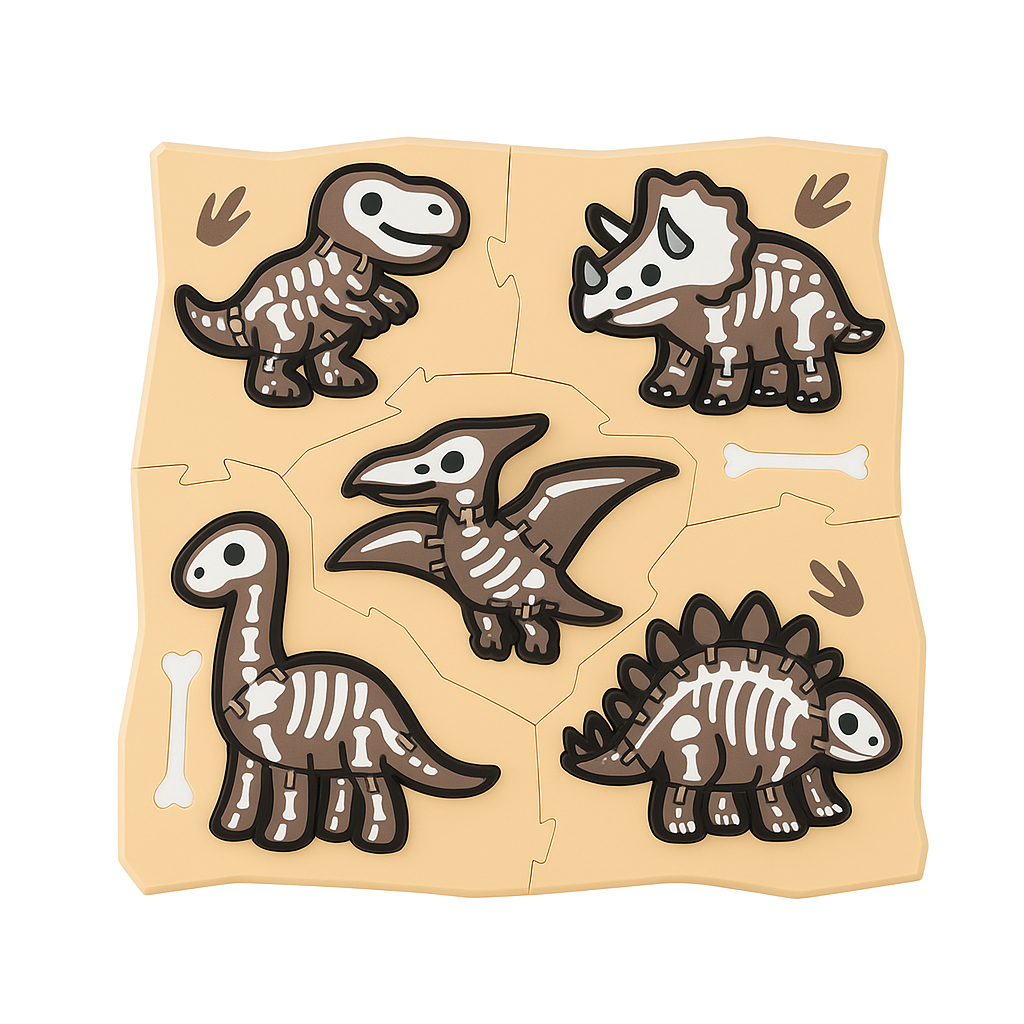Your cart is currently empty!

3D Printable Educational Toys You Should Know About
Hey nerds. Happy fall and happy September. The back-to-school season is upon us. So… here’s a radical thought: learning doesn’t have to be boring.
I know. Shocker. Turns out “educational toy” doesn’t always mean beige plastic, alphabet blocks, or overpriced STEM kits that break after two uses after breaking the bank. Sometimes, it means hitting print, watching your 3D printer do its magic, and ending up with something that’s actually fun and teaches you or your kids/students something useful.
So, I’ve scoured the depths of the 3D printing world (our own website) for many hours (literally 5 minutes) and pulled together some of the coolest educational toys you can print right now. These range from math toys to anatomy models to brain-melting puzzles, and they’re all proof that learning + 3D printing = dangerously good combo.
1. Angle Pie
Let’s start with the basics: math. And before you scroll past this section faster than a high schooler avoiding homework, hear me out: this Angle Pie toy is genius. It breaks down angle measurements into physical, tangible pieces of a pie (because apparently visualizing 90° is easier when it looks like lunch).
It’s one of those tools that sneaks learning into playtime. Kids (and, honestly, adults) can piece together angles, see how they combine, and actually understand geometry instead of just memorizing it for a test they’ll forget tomorrow.
💡 Printing Tip: This one’s a breeze, no supports needed. Use multiple filament colors to make each “slice” pop visually. Trust me, it makes explaining angles 10x easier.
2. Multi-Color Cell Model
This one’s a gem. It’s a 3D cell model, with parts you can print in different colors to represent organelles (nucleus, mitochondria, cell membrane, etc.). Print this if you’re teaching biology, anatomy, or just want a decor piece that makes people go “Huh. Well. That was… a choice?”.
It works beautifully alongside the anatomy model I already had in the list. The difference? This is focused on the microscopic world. It’s a tangible way to explore cell structure. Way more intuitive than a textbook cross-section. Kids (or adults) can assemble it, see how parts fit together, and understand the cell’s architecture in real life.
💡 Printing Tip: Use different filament colors for each organelle piece so they stand out. Print at a decent resolution (0.15-0.2 mm) so the tiny details don’t dissolve. Minimal supports should work, but check in your slicer for overhangs.
3. Tetris Balance – Physics Meets Fidgeting
This one is chef’s kiss. It’s part game, part physics lesson, part chaotic brain teaser. The Tetris Balance mini set is all about stacking pieces in a way that keeps the structure from toppling — teaching balance, gravity, and stability without ever using the word “physics” (which, let’s be honest, is the real educational win).
It’s also a great little travel toy or desk distraction. One of those things you pick up “just to try” and end up playing with for 45 minutes straight.
💡 Printing Tip: It’s small, so it prints quickly. I recommend slightly higher infill (20–25%) so the pieces feel weightier — that makes the balance challenge more satisfying.
4. Accurate Human Anatomy Model
Here’s where things get serious. This anatomy model is one of the most detailed printable human body teaching tools I’ve ever seen. And yes, it’s exactly what it sounds like. Bones, organs, the whole squishy package. It’s incredible for learning biology or for anyone who’s ever said, “I wonder what’s actually in there.”
It’s also surprisingly fun to assemble. Like a grotesque 3D puzzle that makes you smarter.
💡 Printing Tip: This one’s more advanced. You’ll want good detail settings (0.12–0.16 mm layer height) and supports for certain internal parts. If you’re feeling ambitious, multi-color printing really brings it to life.
5. Educational Clock
There’s no polite way to say this: most kids struggle with reading analog clocks. (To be fair, so do a lot of adults. And some of my friends, no shade.) That’s why this educational clock is brilliant. It’s a fully functional learning tool with labeled hours and minutes, perfect for hands-on time-telling practice.
And because you’re printing it, you can scale it up, change the colors, or even customize the labels if you’re teaching in another language.
💡 Printing Tip: Go slow and steady for the gears if you’re printing functional moving parts. PLA is fine, but PETG gives extra durability if you expect lots of little hands twisting the dials.
6. Flexi Puzzles
These puzzles are actually so cute even I, at my prehistoric age, have one. They bend, twist, fold, and lock in ways that force your brain to think spatially. Perfect for kids developing logic skills, or adults of any age healing their inner child. Or if you just like bendy dinosaur puzzles, which I can’t judge you for because I have the dinosaur one as well.
I especially love how modular they are: print a few or the whole set, and watch your worries disappear. This is true for when the puzzle’s for you or your kid.
💡 Printing Tip: These need flexible, durable connections, so slower print speeds and clean layer adhesion are key. No supports necessary.
7. Tic-Tac-Toe
Yes, tic-tac-toe. It’s simple, but hear me out: it’s a fantastic tool for teaching strategic thinking, pattern recognition, and probability. Plus, it’s dead easy to print, which makes it great for classrooms, workshops, or just as a warm-up project.
Also, it’s freaking tic-tac-toe. It’s the ultimate game, c’mon.
💡 Printing Tip: PLA, 0.2 mm, and low infill. It’s about as straightforward as 3D printing gets.
8. Cacti Chess
I’m ending with this absolute masterpiece. Cacti Chess is a roll-up chess set that’s part strategy lesson, part design flex, and +10000 aura points. Printing a chess set is already impressive, but printing one that rolls up and travels with you? That’s top-tier brainiac behavior.
It’s a fantastic way to introduce kids (or adults!) to deeper strategic thinking, and also an excuse to show off your printing skills.
💡 Printing Tip: This one’s more advanced, so expect multiple print sessions and some careful assembly. PETG or ABS will add strength if you plan to roll it up often.
🧠 Final Thoughts
If you’ve ever thought “educational toys” were just overpriced plastic junk, you never will again. I promise. And if you do, at least I tried to help so it’s your fault, really.
With 3D printing, you can build an entire curriculum worth of toys, puzzles, and learning tools right at home. And the best part? You can tweak, remix, scale, and customize every single one of them.
Whether you’re printing for a classroom, a curious kid, or just your own geeky satisfaction, these projects prove that learning doesn’t have to feel like homework. Sometimes, it feels like solving a puzzle. Sometimes, it looks like a cactus-themed chess set. And sometimes… it’s literally a pie chart you can eat (well, not literally. Please don’t eat the PLA. I’m sure you’re thinking “you don’t have to tell me that I’m not an idiot” and you’d be correct. But you are not the only person in the world and there ARE some idiots and kids who just wanna eat colorful things so relax this ain’t about you).
So go ahead. Hit print, learn something new, maybe teach some kids some things too.
That’s a wrap! Go print some cool smart stuff.
NOW!!! omg just go!!
2 responses to “3D Printable Educational Toys You Should Know About”
-
Great post! The fact that all these items are available either as a file or a printed model is awesome.
-
Very smooth… and thanks. (I actually really respect the shameless self-plug)
-

Leave a Reply